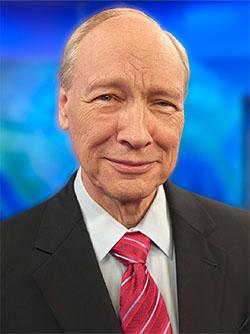Reaching Across the Divide
Even when society is being torn apart by war, ethnic strife, and social unrest, it’s possible for very different people to find mutual respect for one another. This is one such story.
There will be times in our lives when we find ourselves communicating with people we would normally not seek out—or with whom, due to cultural, social, or economic differences, we would not expect to find much common ground. Everyone on this planet is unique as an individual, but we often focus more on how our differences separate us as members of families, groups, tribes, or nations. Yet these differences should not prevent us from reaching across the divide, treating all people with compassion, and developing a deeper understanding of our fellow human beings. After all, we are all made in God’s image.
The Canadian Mounties
During the nineteenth century, on the Canadian prairies in what is now the province of Saskatchewan, James Morrow Walsh was one of the first Canadian Mounties. The North-West Mounted Police (the “NWMP” or “Mounties”) was formed in 1873, not long after the Canadian government’s 1870 purchase of Rupert’s Land, a vast northern territory of nearly 1.5 million square miles around Hudson Bay—about a third the size of today’s Canada.
Young men were commissioned as NWMP officers to maintain law and order in the territory and to curb the illegal whisky trade, which was causing great harm to the native population. These men were granted far-reaching authority even to fulfil the roles of ex officio justices of the peace and acting magistrates. Their presence was also meant to forestall expensive and drawn-out conflicts between settlers and native people, preventing regional destabilization that might tempt the United States to try to expand into Canada.
Walsh arrived at the Cypress Hills in command of B Division, one of six groups sent out by the NWMP, with instructions to establish forts and begin patrolling the region. Fort Walsh was erected in 1875. By the summer of 1877, the pivotal role of Superintendent James Morrow Walsh—and his treatment of someone across a great cultural divide—was recognized across the whole of Canada and became a memorable event in Canadian history.
A Merciful Mountie
After the Sioux chief Sitting Bull and his 2,500 warriors defeated U.S. General Custer and his men at the Battle of Little Bighorn, the tribe travelled north across the border into Canadian territory. With buffalo herds shrinking, and with great animosity festering among the various native tribes, the Sioux—numbering around 5,600—were half-starved and in desperate need of help by the time they approached Fort Walsh.
Walsh rode into the Sioux camp with just two interpreters and six constables from his division, knowing full well that they would be no match for the thousands of warriors under Sitting Bull’s command. The responsibility of Walsh and his constables was to ensure that everyone in their territory respected the rule of law. This is well stated in R. C. Macleod’s The North West Mounted Police 1873-1919:
In this period the emphasis was on educating both Indian and rancher. Each had to be convinced that the other party had rights which must be respected. The closest thing the Mounted Police had to an absolute rule was to avoid the use of firearms except as a last resort. Mounted Policemen regularly rode into armed and excited groups of both races with their guns holstered. They knew that moral authority was the surest defence since they were heavily outnumbered and potential reinforcements were thousands of miles away (1978, p. 8).
Walsh, during his first meeting with Sitting Bull, explained that the laws of the land were to be applied to settlers and natives alike, and that no one could expect to escape punishment. The Sioux chief marvelled that a man with so few companions would approach his camp with such boldness, and he agreed that his tribe would abide by the law enforced by the Mounties. Legend has it that Sitting Bull then gave Walsh three silver medals bearing the image of King George III and proclaimed that he and his tribe sought to live under the protection of the “Great White Mother,” Queen Victoria. Calling themselves “British Indian,” the Sioux hoped to settle in Canada and avoid American retaliation after their defeat of General Custer.
The Canadian government, however, would not agree to Sitting Bull’s request, preferring that the Sioux would cross back over the border into the United States. It therefore fell on Walsh to persuade the Sioux to leave Canada. What followed was a stalemate that lasted several years.
Stalemate with Sitting Bull
Walsh’s negotiations with Sitting Bull became national news, and newspapers across the continent called Walsh “Sitting Bull’s Boss.” It seems that Walsh thought highly of Sitting Bull and wanted to protect him both from the hands of rival tribes struggling over limited food supplies and from America’s policies on territorial expansion. But while Sitting Bull and his Sioux accepted the authority of Walsh and the NWMP, they would not agree to relocate. In 1880, displeased by years of stalemate, the Canadian government under Prime Minister Sir John A. MacDonald transferred Walsh to Fort Qu’Appelle, more than 500 kilometres (310 miles) to the east.
According to historian Grant MacEwan, “That summer the lack of buffalo and the refusal of the Canadian government to give the Sioux either a reservation or food led many to go back to the United States which had promised provisions” (“Ta-Tanka I-Yotank,” Biographi.ca, 1982). By 1881, Sitting Bull had agreed to terms with the U.S. government. After seeing that the Sioux who had returned were being treated decently, he crossed back over the border.
A decade later, Sitting Bull was again at the center of controversy because of his prominent role in what was called the “Ghost Dance” movement, which sought the overthrow of settler rule and the restoration of Native American sovereignty and prosperity across the lands controlled by the U.S. and Canada. The governments of both nations feared a native uprising, and a warrant was issued for Sitting Bull’s arrest. Tragically, when an arrest was attempted, shots were fired and Sitting Bull was among those killed.
Peace and Goodwill on Earth
Upon hearing of Sitting Bull’s death, Walsh offered words of praise, saying “He was not a cruel man, he was kind of heart; he was not dishonest, he was truthful” (Biographi.ca). Walsh’s respectful communication with, and kind treatment of, a man and his people who came from an almost entirely alien cultural background should be an example for us. Despite the obstacles, we should strive to treat others as we would want to be treated. Every human being is made in God’s image and deserves to be treated as such.
Yet, just as Walsh was unable by himself to secure an agreement between Sitting Bull and the Canadian government, all human attempts at maintaining law and justice will fail to a greater or lesser degree. It will ultimately require divine intervention to bring about that goal toward which we all must strive in the meantime. In the coming Kingdom of God, the King—Jesus Christ—will ensure that His laws are followed. These laws will not only enable healthy communication between nations; they will go a step further, laying the groundwork for sincere friendships between people of all cultures, and enabling all mankind to truly “love your neighbor as yourself.”
Until then, those of us now learning to apply God’s way of life should remember that “if a stranger dwells with you in your land, you shall not mistreat him. The stranger who dwells among you shall be to you as one born among you, and you shall love him as yourself; for you were strangers in the land of Egypt: I am the Lord your God” (Leviticus 19:33–34).






